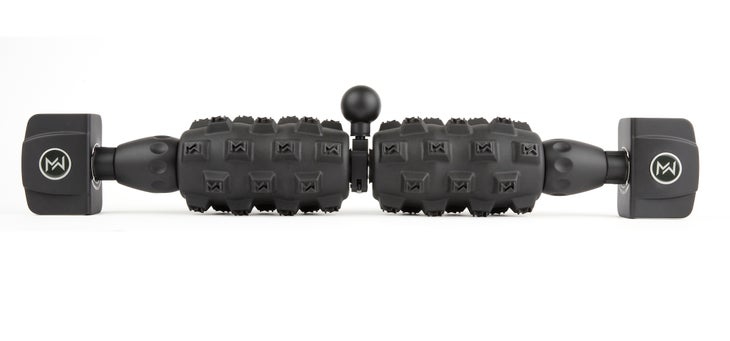New perk! Get after it with local recommendations just for you. Discover nearby events, routes out your door, and hidden gems when you sign up for the Local Running Drop.
When it comes to must-have items that triathletes need, there’s no denying the foam roller is an essential item. The Mobility Wall takes that basic concept of the foam roller and gives it quite the upgrade—it’s like the Rolls Royce of foam rollers.
The Mobility Wall uses pressure to sit inside a doorframe and allow you to roll against it while standing; no laying on the floor involved! There are three different types available: the Smooth Roller, the Smooth Roller Deluxe, and the Pro Series. We tested the Pro Series, which features a textured split foam roller plus four different attachments. Be warned: The knobs along this roller are most definitely designed to hit the spot; they’re beefy and heavy duty, and will certainly help work out knots, tension, and provide quite the deep tissue experience. For this reason, it’s good to start out slowly and gently, and make the most of the fact you’re in charge of controlling the pressure. The four different attachments are each designed to help you hit certain spots/muscle groups. The small ball attachment and the bullet attachment became my most-used: the small ball is for targeting the biceps, triceps, and lateral shoulder, while the bullet is perfect for the individual vertebrae along your spine, as well as the bottom of your feet (and for anyone running in snow/icy conditions at the moment, this became quite the post-run self-massage tool). There’s also a fork attachment (good for the back of your neck or arms) and a larger ball attachment, meant for larger muscle groups like quads and hammies.
Mobility Wall: What We Liked
As someone who likes to swim before work and then proceeds to spend the next eight hours hunched over a laptop, I tend to get very tight in the upper back, neck, pecs, and shoulders—and I’m guessing that’s something not unfamiliar to a lot of triathletes. It’s here that I gave the Mobility Wall its first gold star. When it comes to accessing these parts of the body, it far exceeds what a standard foam roller is capable of. It can be challenging to be on the floor and access your neck, pecs, and lats—as well as control the force/pressure you’re applying—yet with the Mobility Wall, it’s a cinch. You’re maneuvering around the Mobility Wall and then applying the pressure, whereas when you’re on the floor with a foam roller that’s significantly harder to do. The Mobility Wall was designed so you don’t have to get anywhere near the floor—you can stay upright and apply the force/pressure that works for you. You can also ease into it gently. If something feels sore to begin with, you can take it slowly and gently, and back off whenever needed.
Mobility Wall: What Could Be Better
The set-up process wasn’t as quick or easy as we first thought it might be; it definitely takes a bit of time to ensure you’ve got the Mobility Wall at the correct height and, of course, safely secured in your doorframe. Once all set up, though, there’s no denying it’s a handy piece of kit that makes rolling and self-massage extremely convenient.
The Pro Series features some fairly aggressive textured “knobbly bits” which, unless you’re a little prudent to begin with, can catch you unawares, so try not to be too “Type A” with the Mobility Wall, especially when you first begin using it, as it means business. It’s not often here at Triathlete that we get to borrow from the Grateful Dead, but the lyrics from Shakedown Street spring to mind: “Maybe you’ve had too much too fast” is not a place you want to find yourself with the Mobility Wall. Gently experiment by applying different levels of pressure, particularly when rolling and massaging smaller/finer muscle groups. It’s easy to overdo it!

Mobility Wall Final Word
One of the key things we’ve found with any kind of self-massage tool is that the best gear is the gear that’s easy to use, time and again.
With a $150 price tag, the Mobility Wall isn’t a cheap piece of equipment. Yes, it’s considerably more advanced than your standard foam roller, but it’s still an investment that’ll really only give you the returns you’re looking for if you use it regularly. For this reason, if you’re someone who can set it up somewhere convenient and build it into your everyday self-care routine, then perfect: the Mobility Wall is likely a piece of kit that’ll help keep you off the injury bench all season long. But if you don’t have somewhere to set this up and keep it up (which I currently don’t), then you might find a standard foam roller is a better, more cost-effective option.
